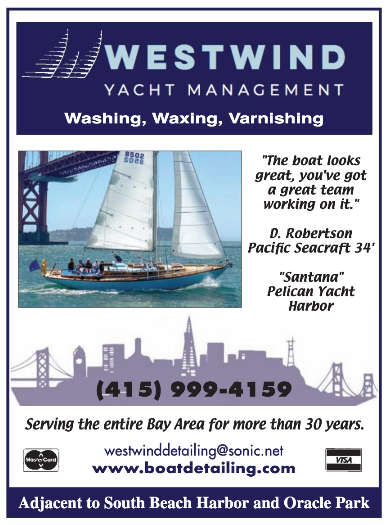
The Rudderless ‘Lucky Dog’ Is Resurrected
Four months ago Jeanne and Dan Streiff left Mexico on their Seattle-based Catalina 470 Lucky Dog for the trip of a lifetime. They were just two weeks into their passage to the Marquesas when disaster struck with the loss of their rudder, for no apparent reason. Jeanne told the story of misfortune turning to salvation when they abandoned Lucky Dog and then were able to return to her and bring her into Hiva Oa for repairs.
We recently heard from Jeanne, who let us know that after much creative and resourceful effort, they’ve managed to build a replacement rudder in Hiva Oa. Jeanne wrote, “Here is our new rudder! (Emergency one shown on back of boat; really illustrates what we were missing!).”
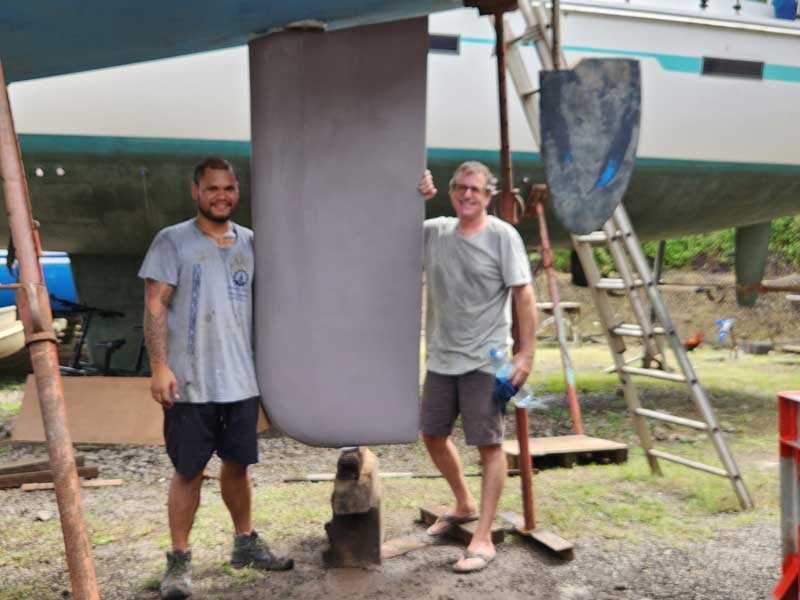
They documented the build of the new rudder on Instagram showing the whole process of fashioning the rudder with marine plywood over stainless steel, then shaping, fiberglassing and painting. Then, “Tadaa! — it’s now installed.”
Beyond building a new rudder from scratch in the South Pacific, this huge interruption in their plans has forced some other adjustments to their schedule. As Jeanne describes, “We only got a one-month extension on our 90-day visa, so we are heading back to British Columbia and keeping her in the yard in Hiva Oa until next March — through cyclone season. We are looking at this as a giant reset button for our cruising. Next year should be great. At that point, we will test the rudder out nearby, then keep going. We are so grateful for all of the local support in Hiva Oa. We are really so very lucky.”
There are some products and places where you can’t get things from Amazon Prime overnight, so it’s still true that cruisers have to be flexible and resourceful when setting off on a voyage. The ability to find a French cruiser to help them find their abandoned boat, bring it back to Hiva Oa, and then build a new rudder on site highlights the best of these cruising traits. We look forward to hearing more from Jeanne and Dan when they return to Lucky Dog next spring.
Hurricane Hilary Aiming for Baja and SoCal
The Eastern Pacific hurricane season has had eight named storms, with most heading west toward Hawaii. Last month, Hurricane Calvin threatened the islands and many boats that had just arrived after the Transpac and the Singlehanded Transpacific Race, but it left without causing much damage. This was immediately followed by Hurricane Dora, whose winds helped create the inferno that engulfed Lahaina last week. Now the hurricane course has shifted with the onset of Hurricane Hilary on the Baja coast.
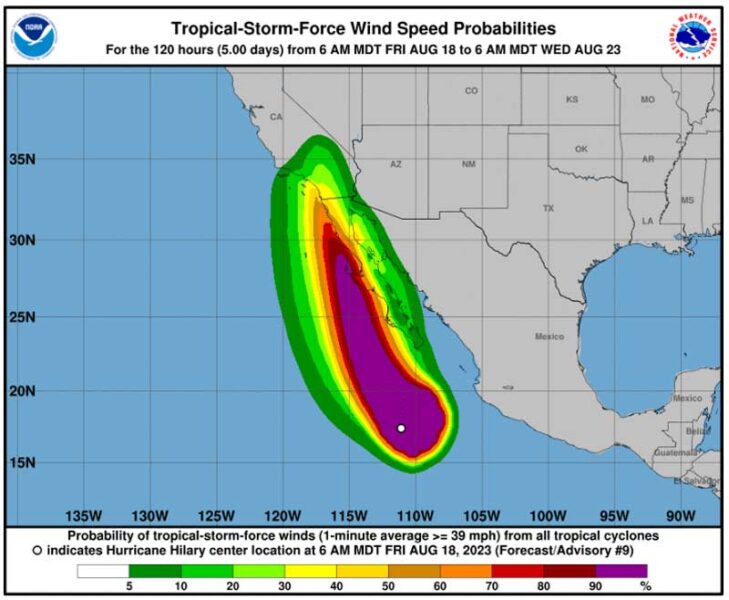
The tropical storm became a hurricane yesterday morning, with its track shown to head north up the west coast of the Baja peninsula and eventually reach Southern California. “Eventually” is not that far away. The eye of the storm is predicted to pass offshore of the Baja Ha-Ha stops of Bahia Santa Maria and Turtle Bay on Saturday, and to reach Southern California on Sunday afternoon/evening.
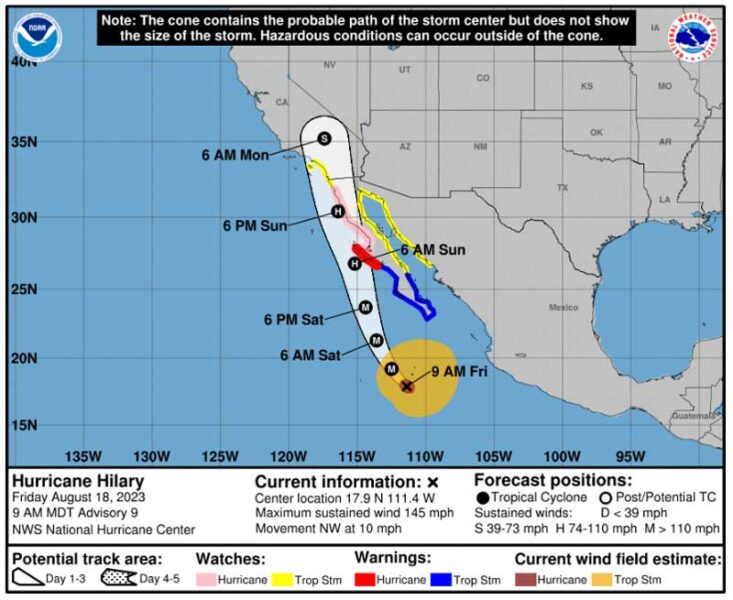
Hilary has already been forecast to accelerate to a Category 4 by Saturday morning as it passes west of Baja’s west coast, leaving the southwest-facing anchorages vulnerable. It could cause significant damage depending on where it makes landfall, which, on its present course, could be somewhere near Ensenada. The projected course will also bring it very close to Turtle Bay. Winds are expected to diminish as it reaches cooler water and starts to hit land, perhaps coming ashore as a Category 1 or tropical storm.
This is one to watch for Baja and Southern California, where it could produce big winds, heavy rain, big surf and flooding. BoatUS is advising boats in Southern California marinas to batten down the hatches by adding docklines and fenders, and reducing windage by removing roller-furling headsails or anything that adds wind resistance. Boats should also secure portholes and hatches, and ensure scuppers and drains are clear so heavy rains can exit the boat.
Visit Naos Yachts at a Fall 2023 Boat Show
The Resourceful Sailor: What’s Your Favorite Tool, and Why?
“What is your favorite tool?” the Resourceful Sailor asked Olivier Huin, captain and builder of Breskell, a 50-ft cold-molded sloop, as they prepared for their 2019 transit of the Northwest Passage. Without hesitation, “My Leatherman,” was his reply. I can confirm he used it often, on a par with his use of epoxy. Personally, I fear the Leatherman as much as I fear Vise-Grips. While they often can do the job, they disfigure anything they touch. When they fail to work, they REALLY disfigure it. But for Olivier, it was a clutch performer because it was always at his side. To each their own.
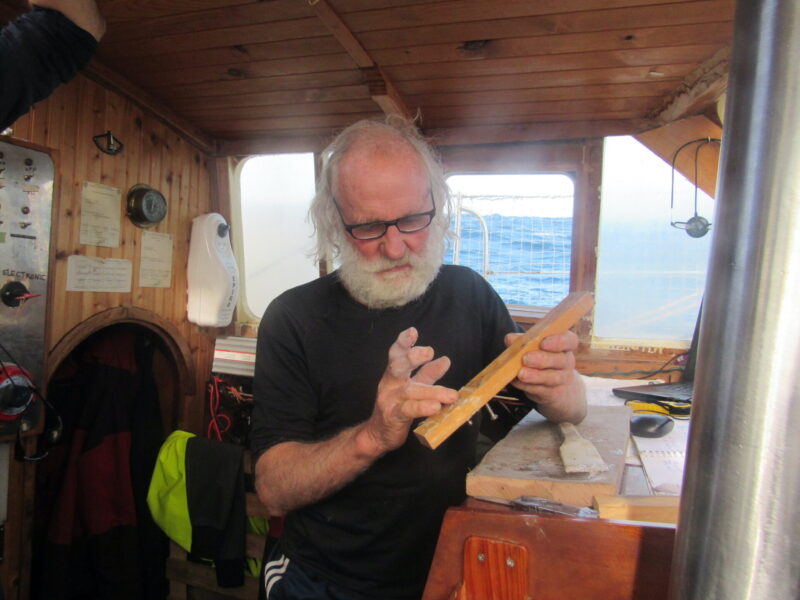
After some thought, the Resourceful Sailor decided his clutch performer was a simple vanity mirror. No jokes, please. The kind you buy at the local pharmacy or department store. This mirror has been used plenty for shaving and other hygiene purposes best left unspecified, but who cares about that? Its Resourceful Sailor value comes from viewing the nooks and crannies of Sampaguita, a Pacific Seacraft Flicka 20, where the eyes cannot directly see, and its companion, the flashlight, because those nooks are also typically not well lit.
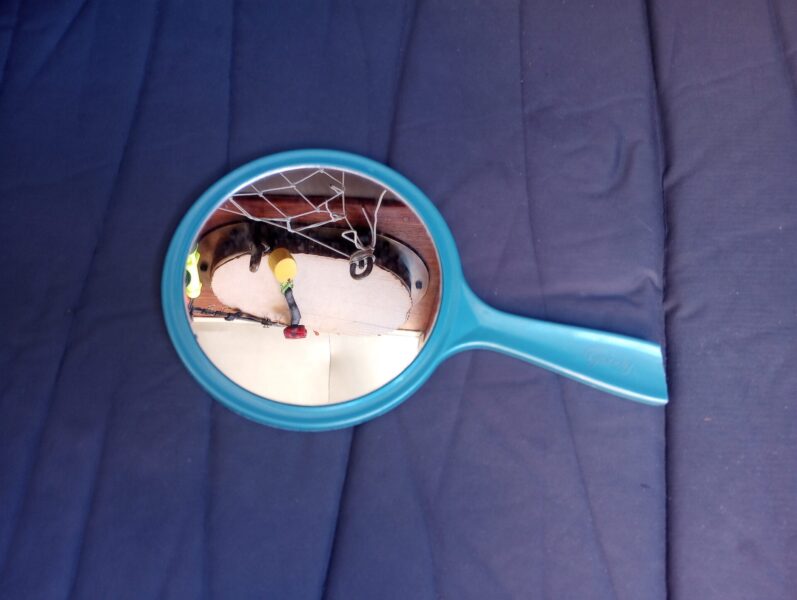
Wiring the Tillerpilot? Get the mirror. Removing chainplates? Get the mirror. Installing the windvane to the transom? Pull out the mirror. All three jobs were accessed through the cockpit locker, too small for the Resourceful Sailor to fit much more than his hands into. The image shows a broken handle. That happened when the cockpit locker inadvertently slammed down on it.
In the projects mentioned above, I used the mirror and the light to study the blind work area, where any fasteners were, and anything in the way. But when doing the work, the hands often blocked the view, so it was by feel. I translated what I’d previously viewed through the mirror into what my hands were feeling, remembering (or trying to) that visions in the mirror were opposite from reality.
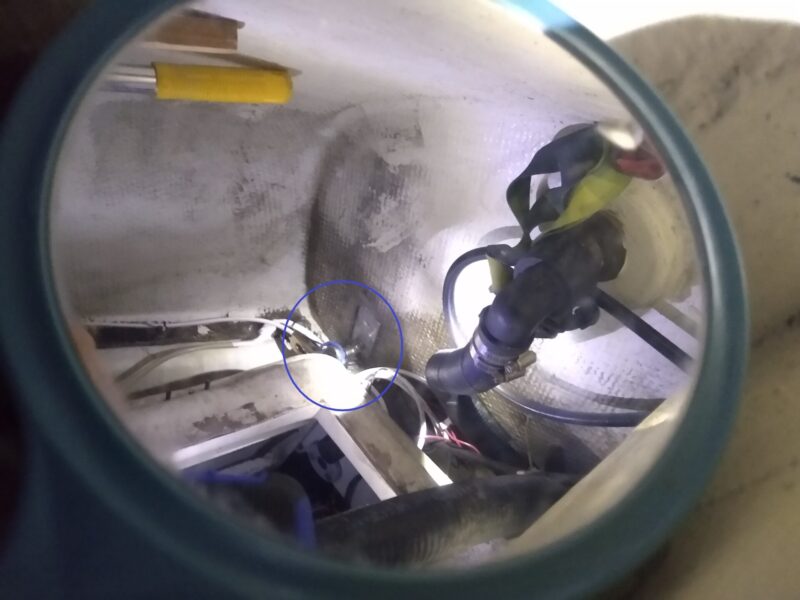
The mirror is used in other places too. The forepeak, the bilge, the transom, under the galley, and in the quarter berth come to mind. Important enough to have a spare. Luckily, they were sold in pairs. This interdisciplinary tool is kept in the hygiene bin instead of the toolbox to avoid breakage. The next time a repair requires boat-yoga, ask if a mirror might substitute for Houdini-like feats. Remember, keep your solutions safe and prudent, and have a blast.
But never mind about me. What is your favorite tool, and why?
Want More Movies on Sailing at the International Ocean Film Festival?
The annual International Ocean Film Festival is an event we look forward to each year. Largely because we love the ocean that covers at least 70 percent of the planet and provides us with our vast playground. But we also look forward to the festival in hopes of catching a film about sailing (of course). We know most of the films don’t cover our favorite topic, but there’s no reason for there to be none at all. All it takes is for an aspiring, enthusiastic filmmaker (and yes, amateur counts) to create a film that fits within any of the listed award categories.
“The film festival considers films of all genres which focus on the many varied aspects of our big, blue ocean. Award categories include Animation, Conservation, Coastal and Island Cultures, Director, DEI, Environment, Female Filmmaker, Golden Gate (recognition of a local Bay Area filmmaker), Innovation, Marine Science/Wildlife, Ocean Sports and Exploration, and Short.” How hard can it be? (cough …)
But seriously, the International Ocean Film Foundation (IOFF) is now calling for submissions for next year’s 21st Film Festival. We would love to see a couple of sailing-related films on the program.
Here’s an example (and a suggestion if you’re reading this, Call of the Sea): The IOFF offers an Annual Free Student Education Program. It’s described as “an opportunity for middle school and high school students to discover a wide range of ocean related topics such as marine wildlife, conservation efforts, maritime sports, environmental issues, international coastal cultures and global efforts to help protect our oceans and [their] diverse ecosystems.” Imagine if this program were combined with youth educational sails on the Bay or along the coastline.
The IOFF also hosts an Ocean Filmmaking Workshop, which “is designed to teach young middle school and high school students the basic principles of creating and producing a film about the ocean.” There’s also the Annual Student Film Competition, with submissions opening on September 1.
Does anyone know anyone who could take advantage of these opportunities? (If only we were still in school …)
Here’s the trailer from the 2023 International Ocean Film Festival to get your creative mind ticking:
The call for film submissions is now open. Early deadline is October 12. Regular deadline is December 31.
We can see that this is short notice, particularly if you haven’t even thought about doing anything. But maybe you have something partially completed in the bottom drawer? Or maybe this can serve as notice for the next round of submissions?
If you would like to know more about submitting a film, check the IOFF’s page FilmFreeway.com. For information about the Free Student Education Program, check here. And for the Student Film Competition, click here.
The International Ocean Film Festival, now in its 21st year, is considered the largest ocean-themed film festival in the world. The organization behind it works with the vision of “a world with healthy and productive oceans for the benefit of all” facilitated through a “platform for ocean literacy and education through independent film.”
We hope to see some local names in the program for next year’s International Ocean Film Festival, which will run April 13–14, 2024, in San Francisco.
Westwind Yacht Management — Washing, Waxing and Varnishing
Westwind Yacht Management: Premiere Yacht & Fleet services for the San Francisco Bay Area.


